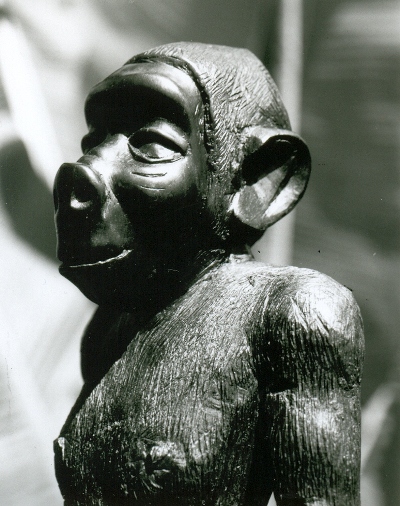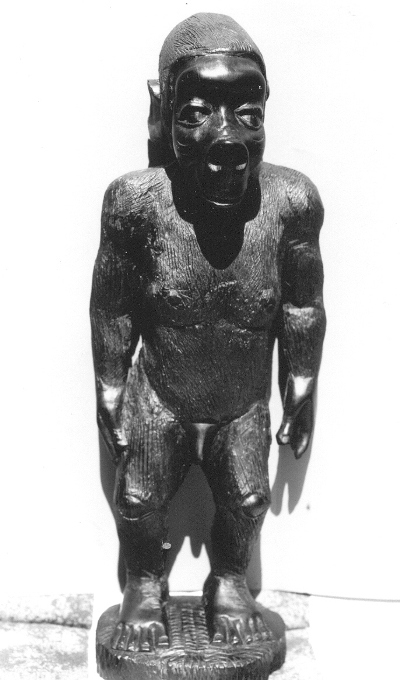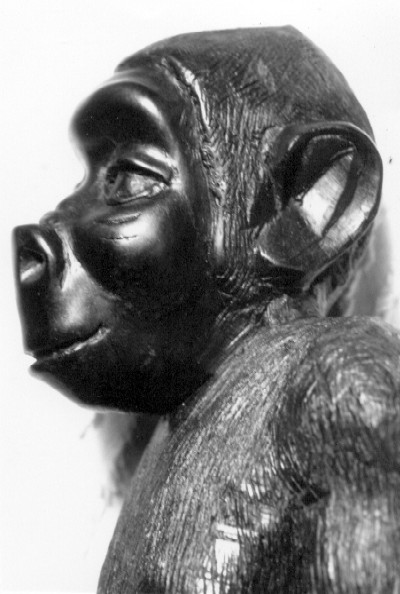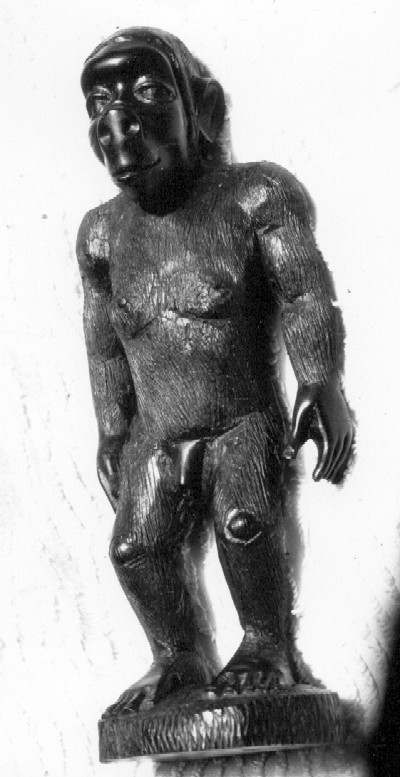The Agogwe
Posted by: Loren Coleman on December 6th, 2006

I want to share an addition to the International Cryptozoology Museum, a new sculpture whose photographs are seen about this blog. It represents a depiction of the Agogwe from Tanzania (Jamhuri ya Muungano wa Tanzania), and gives me this opportunity to introduce these hominoids here.
The following is my summary description of this unknown African hominoid:
Agogwe
The Agogwe is a downy-haired little unknown biped reported throughout east Africa. Said to have yellowish, reddish skin underneath its rust-colored hair, the Agogwe allegedly inhabits the forest of this remote region.
One of the most discussed sightings occurred near the turn of the nineteenth century when Capt. William Hichens was sent on an official lion hunt to this region. While there, waiting in a forest clearing for a man-eater, he saw, as he would write, December 1937, in the London magazine Discovery: “two small, brown, furry creatures come from the dense forest on one side of the glade and disappear into the thickets on the other. They were like little men, about four feet high, walking upright, but clad in russet hair. The native hunter with me gazed in mingled fear and amazement. They were, he said, agogwe, the little furry men whom one does not see once in a lifetime. I made desperate efforts to find them, but without avail in that wellnigh impentratable forest.”

In support of Hichens’s story, Cuthbert Burgoyne wrote a letter to Discovery in 1938, noting that he and his wife had seen something similar while coasting Portuguese East Africa [known today as Mozambique] in a Japanese cargo boat in 1927. Close enough to shore to see things on the beach using a “glass of twelve magnifications,” they spied a troupe of feeding baboons, apparently picking up shellfish or crabs. “As we watched, two little brown men walked together out of the bush and down amongst the baboons. They were certainly not any known monkey and yet they must have been akin or they would have disturbed the baboons. They were too far away to see in detail, but these small human-like animals were probably between four and five feet tall, quite upright and graceful in figure. At the time I was thrilled as they were quite evidently no beast of which I had heard or read. Later a friend and big game hunter told me he was in Portuguese East Africa [Mozambique] with his wife and three hunters, and saw a mother, father and child, of apparently a similar animal species, walk across the further side of a bush clearing. The natives loudly forbade him to shoot.”

These long-haired beings of small size are known by a variety of names throughout Africa, including in the Congo, they are called kakundakári; in central Africa as amajungi or niaka-ambuguza; in East Africa as agogwe, doko, mau, or mberikimo; in southern Africa as chimanimani or tokoleshe; and in West Africa as abonesi, ijiméré, or séhité. Various attention has been given to these reports in different decades. For example, there were widespread reports of reddish-haired séhité in 1940s’ Ivory Coast (more properly known today at République de Côte d’Ivoire), where there were no known pygmies at all.
British primatologist W. C. Osman Hill, when talking about similar hominids in South Asia, the nittaewo of Sri Lanka (formerly Ceylon), felt they were a small form of Homo erectus. Scottish-American zoologist Ivan T. Sanderson considered that some proto-pygmies might simply be unclassified pygmy Homo sapiens who have retreated into the rainforests and tropical mountain valleys of Africa or Asia. The French zoologist Bernard Heuvelmans considered the small African creatures may be proto-pygmies, proto-bushmen, or australopithecine (gracile species). In On the Track of Unknown Animals, Heuvelmans commented: “Now there is no known ape, even among the anthropoids, which normally walks upright on its hind legs….Perhaps the agogwe are therefore really little men.”

The above information is adapted from The Field Guide of Bigfoot and Other Mystery Primates (NY: Anomalist Books, 2006), and Cryptozoology A to Z: The Encyclopedia of Loch Monsters, Sasquatch, Chupacabras, and Other Authentic Mysteries of Nature (NY: Simon and Schuster, 1999).

Merci – Christian Le Noel & Philippe Bloch, Loren
Update: December 7, 2006
I was informed by Christian Le Noel that this statue was from Tanzania and representing an Agogwe. However, Jean luc Drevillion tells me today that this is incorrect. Drevillion says it is a statuette of Kara-Komba or the bush dwarf or Toulou, which is the local form of the proto-pygmy in the Central African Republic. (He writes in French: Cette statuette représente un Kara-Komba ou nain de brousse ou Toulou qui est la forme locale du proto pygmée dans la République centrafricaine).
My understanding, nevertheless, is that this is a form of the proto-pygmy of which Agogwe is one name and Kara-Komba another, depending on the location and informant. I will further explore this.
🙂
To learn more about Kara-Komba, see here and here.
Appreciation to Jean luc Drevillion for this information, new links, and clarification.
About Loren Coleman
Loren Coleman is one of the world’s leading cryptozoologists, some say “the” leading living cryptozoologist. Certainly, he is acknowledged as the current living American researcher and writer who has most popularized cryptozoology in the late 20th and early 21st centuries.
Starting his fieldwork and investigations in 1960, after traveling and trekking extensively in pursuit of cryptozoological mysteries, Coleman began writing to share his experiences in 1969. An honorary member of Ivan T. Sanderson’s Society for the Investigation of the Unexplained in the 1970s, Coleman has been bestowed with similar honorary memberships of the North Idaho College Cryptozoology Club in 1983, and in subsequent years, that of the British Columbia Scientific Cryptozoology Club, CryptoSafari International, and other international organizations. He was also a Life Member and Benefactor of the International Society of Cryptozoology (now-defunct).
Loren Coleman’s daily blog, as a member of the Cryptomundo Team, served as an ongoing avenue of communication for the ever-growing body of cryptozoo news from 2005 through 2013. He returned as an infrequent contributor beginning Halloween week of 2015.
Coleman is the founder in 2003, and current director of the International Cryptozoology Museum in Portland, Maine.










Kind of reminds me of a baboon.
I get the feeling of a chimp look. Perhaps some thinking they are seeing chinps have seen these instead?
They all seem to stress that it was fully upright. This brings to mind two ideas considering fairly recent developments.
1- The chimpanzee “Oliver” used to walk completely upright when he was younger. This can be seen in tapes of tv appearances and such.
2- Considering the similarities in descriptions (I think), could there be a potential link with Florensis, the “Hobbit”?
For some reason I can’t quite put my finger on yet, I find it slightly disturbing but also haunting; but maybe that’s got something to do with it reminding me of Venus’ alien pet, Zoony, from the old b/w TV puppet-based children’s science fiction series ‘Fireball XL5’.
This is interesting. Are the statues realistic depictions, or are they stylized representations?
Did anyone notice the shape of the hands, and how they don’t appear to be chimp like. Also, the feet aren’t chimp like. and I just thought about the descriptions of Bigfoot and other mystery hominids and in that they have no hair on their knees. The sculpture also has no hair on its knees.
Very interesting post. Thanks, Loren. Its nice to read something other than the Bigfoot is Human stuff.
Ceroill posted my thought exactly. Is there a possibility that the Flores Man ais an Agogwe?
I saw this article linked on BoingBoing, and came to check it out. Struck a chord right away, because I live on an Indian Reservation in southwest Colorado. When I first came here, I questioned my girlfriend and her family about their folklore. One story was about small, orange haired ‘monkeys’ that roamed the high chaparral in remote areas here. I wonder if anyone else of Native descent has similar tribal stories of these in the States.
When I visited the Kakamega Forest National Reserve in western Kenya a few years ago I recall being told by locals of elusive ‘mystery apes’ living in the forest. The Agogwe, or related species is a possible candidate.
These sightings are very curious. The natives sure didn’t seem to think these were chimps. Not all native accounts turn out to be mere folklore, either. Gorillas are an example that springs to mind. Have there been any sightings of these in modern days?
Makes you wonder just how many others may still be out there. Cute little buggers. I hope all of these can be found soon. BugMO mentions no hair on the knees. I don’t remember (would check but have slow internet connection) but does the footage we have been arguing over as of late show if the big foot in question has hairy knees? If not, the man making the statement that the big foot is a human may be right, just not in the way he is thinking.
To prove these little people of the forest science needs a body to examine. It would be nice for a person to get a photo or video of these things just like supposedly bigfoot sightings claims from people who have seen them. They never have a camera or a videotape machine. It’s all, I seen this, I saw that. Once and for all science needs PROOF.
Interestingly, Pepi II, the last ruler of the Old Kingdom of ancient Egypt, briefly had a “pygmy” who had been captured in Nubia by one of Pepi’s governors. The little man died shortly after being brought to Egypt, and the heartbroken boy king (Pepi came to the throne at age 6) tried to obtain another dwarf, but was never able to do so. There are no “pygmies” in Nubia, now Ethiopia, today… makes one wonder.
There was also the Egyptian deity Bes, in the form of a bestial faced dwarf. Not animal headed, but odd facial features. Protruding tongue, ears and mane of a lion, wore animal furs. Here is one article: “Bes.” Encyclopedia Mythica from Encyclopedia Mythica Online.
[Accessed December 13, 2006].